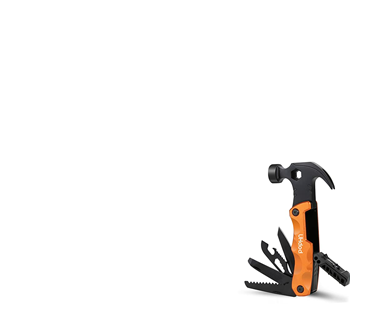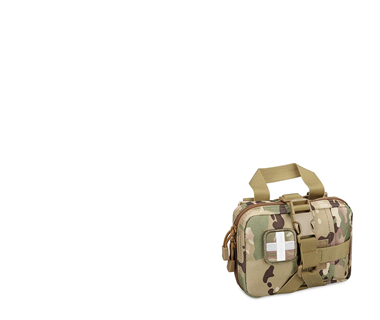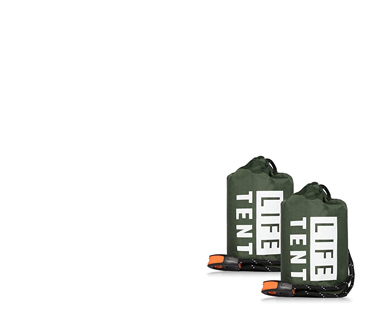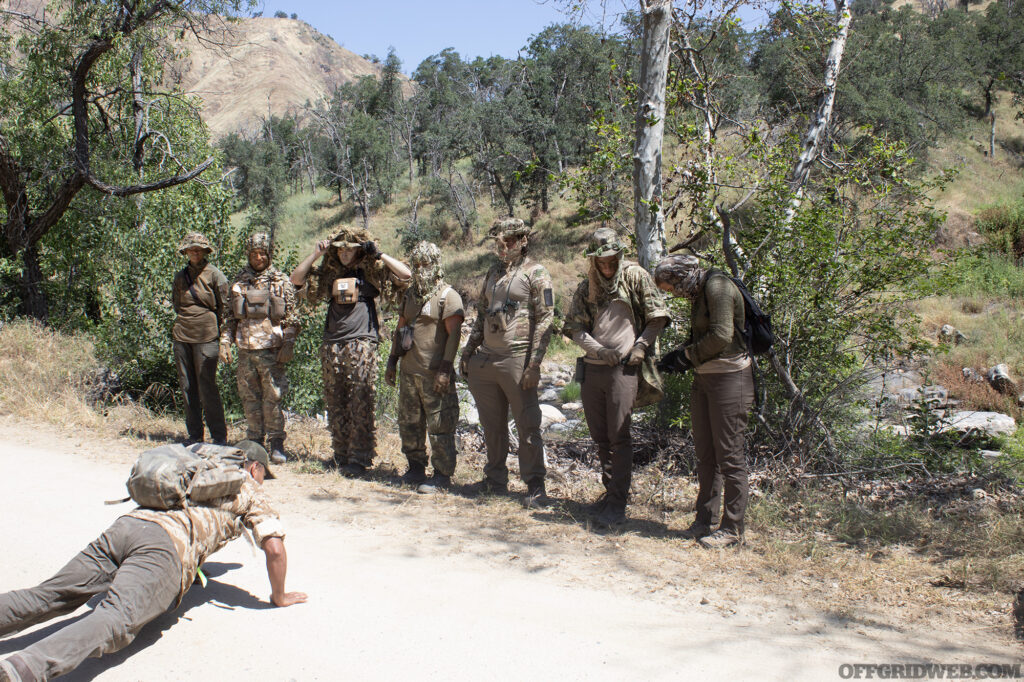Unveiling Camostalk 360 Leave a comment
Imagine being able to create a ghillie suit with nothing more than a knife in the wilderness. This might sound like a scene from a survival movie, but it’s a skill you can learn in Greenside Training’s Camostalk 360 course. Led by renowned expert Freddy Osuna, Greenside Training is Native American owned and operated, and the skills taught are constantly being updated to keep up with the changing times. Camostalk 360 is one of Greenside’s newest courses, inspired by the need to integrate moving undetected with the latest in observation theory.
Above: Camostalk 360 students are shown a movement demonstration before embarking on their final Stalk Lane.
The most recent class was held near Pine Flat Lake, California, in the rolling foothills of the Sierra National Forest, and offered an immersive experience into the art of camouflage and tracking. Respected sniper trainer, Gerald Hooee, joined our class as an assistant instructor. Over the course of two days, we had the privileged opportunity to learn fieldcraft from two of the most trusted subject matter experts of modern times.
A Glimpse into Greenside Training
The Marine Corps categorizes environments into three “sides”, Greenside for non-urban areas, Greyside for urban areas, and Blackside for high-risk or classified operations. Freddy Osuna specializes in Greenside operations. With a heritage that includes being part of the only unconquered tribe, the Yaqui, Freddy brings a unique perspective to tracking and survival.
His journey began at a young age, marked by an intense experience of being kidnapped by cartels at five years old. This ordeal, which included being zip-tied and forced to fight peers and animals, ended with a violent rescue. Through these experiences, Freddy learned the value of life and compassion, traits he believes are essential for a true warrior. His military career as a Marine Corps Scout Sniper further honed his skills.
Above: Assistant instructor Gerald Hooee (pronounced who-ee), scans the valley below for signs of movement from students attempting to identify his position without being seen.
Gerald Hooee, the co-instructor, is a top Marine Corps sniper trainer who fought in the battles of Fallujah and Ramadi during the Global War on Terror. His expertise includes rooftop and urban sniper instruction, as well as tracking and anti-tracking techniques. Both Freddy and Hooee bring an abundance of expertise to each class, and instruction is filled with the wisdom of their experiences.
Foundations of Camouflage and Movement
The course kicked off with an orientation and safety brief. Participants were reminded of the potential dangers in the wilderness, from stinging insects to poisonous snakes and plants. We were also oriented to the formidable terrain around us. The foothills of the Sierra’s may look like gentle, grassy oak savannah, but they are often impossibly steep and riddled with rocky outcroppings.
Knowing that we would be spending the weekend traversing over this type of terrain meant the potential for serious injury if we were not careful. Compounding the potential risks was the fact that our remote training location meant little to non-existent cell service. As a class, we were truly relying on one another to stay out of trouble.
Above: A student peers through the branches of a fallen tree to keep eyes on a fixed target without being seen.
Following the safety brief, we introduced ourselves. It was clear that students were drawn to the course for many reasons. Most heard of Greenside Training by word of mouth. Several others had taken some of Freddy’s courses before and came to this one out of appreciation for Greenside’s approach to training. But no matter what the reason for coming was, everyone had a desire to master the art of undetected movement.
Camouflage Techniques
On Day 1, the first lessons focused on the fundamentals of camouflage. Freddy and Gerald explained the three primary reasons we see things: movement, shape, and contrast. Movement, especially of the head and hands, is the most significant giveaway. Shape and contrast, which include the outline and hue of objects, also play crucial roles.
Participants learned about the importance of coloring in camouflage. Incorporating colors that art too dark should be avoided as they are harder to lighten. Brown or tan are recommended as base colors. High spots on the face should be darkened, while low spots should be lightened using camo paint. This technique helps blend the face into the environment.
Above: Building a ghillie veil or suit with what can be found off the land is a vital skill in Greenside operations.
The Purkinje effect, where rods in our eyes (responsible for black and white vision) take over from cones (responsible for color vision) as it gets dark, was also discussed. As the light of day fades, oranges and reds become less detectable, while greens and blues become more vibrant. Understanding this concept helps in choosing the right colors for different times of the day.
Movement and Observation
Humans are considered the ultimate apex predators due to our intelligence and ability to thermoregulate. This allows us to keep moving when other animals need to rest, improving our chances of successfully hunting game animals. It also means that we must exercise more caution when tracking a potentially dangerous human being. Our instructors emphasized the importance of avoiding detection by using movement techniques that do not counter natural movements. Staying low, getting into shadows, and avoiding direct sunlight are key strategies.
Above: Each student leveraged their own unique view of how natural materials could be integrated into their personal camouflage.
Freddy introduced various search methods, such as the overlapping strip search for scanning the horizon and the micro point method for detailed inspection. We utilized optics to practice this task, which enhanced our vision and allowed us to peer deeper into the surrounding vegetation than we normally could with the naked eye. The goal is to detect fragments of human presence or their equipment, which can be as small as less than an inch at 100 yards.
Concealment Strategies
The session on concealment covered micro and static hides, blinds, and using vegetation for cover. Avoiding “target indicators”—actions or inactions that reveal your presence— is crucial. For example, garbage or gear left behind are obvious target indicators, whereas leaving tracks, or other signs of your presence in the surrounding vegetation are more subtle. We are advised to take a little extra time to conceal or erase anything that would tell a tracker or trained observer that you were there.
Above: Students were taught to find breaks in the vegetation to “burn through” with their optics, further enhancing their concealment from observers attempting to locate where they were hiding.
Another concealment strategy that can be incorporated into personal camouflage is to wear dark colors on top and light colors on the bottom. Doing this can mimic the browse lines common to vegetation eaten by ungulates, and help you blend into the wilderness. Reducing noise from clothing and equipment is another important aspect of concealment. Freddy and Hooee stressed that working with minimal materials is possible. The key is to use what’s available in the environment effectively. Because depth perception can be tricky through magnified optics, understanding how to blend into different backgrounds is vital when trying to defeat someone looking for you.
Seeing Through The Veil
After tweaking our camo and learning as much as we could about stealth vs. observation, Freddy brought us to a spot along a nearby river. Here we discussed how we, through no fault of our own, must fabricate illusions on our lives to blend in with our environment. For some, this could mean wearing the proverbial mask of a corporate business man, or concealing empathy behind the bulwark of authoritativeness.
But for most, it’s the little things we do to fit into our society, communities and culture. However, these are just illusions keeping us from being our true selves. To become one with our surroundings, we need to cast these illusions aside and approach our environment with humility and vulnerability.
Above: A mountain river provided both a physical and symbolic rite of passage for the Camostalk 360 class.
Pointing to the swiftly moving water of the river, Freddy instructs us to crawl from the bank we are standing on to the other and back again. We are to be mindful of the power of the nature that surrounds us, and as the water washes over us, let it sweep away the ego and illusions we shield ourselves with. It is a baptism of river and stone.
An intimate connection to our true surroundings. As we emerge from the waters back to dry land, we feel a deeper connection to the vast wilderness we must contend with and find ourselves more honest about our own capabilities than we were previously willing to admit. This new mindset, Freddy emphasizes, is what will determine success or failure during the final exercise of the class.
Practical Application
In the afternoon, we split into teams and took turns honing the skills we learned about earlier in the day. One team spent 10 minutes getting into a concealed position where they could observe a target, hopefully undedicated. The other team stood near the target and scanned for the concealed team with optics, carefully peering through the vegetation for fragments of their presence.
Above: Students were able to implement the observation skills they learned in an attempt to locate someone trying to remain concealed in the woodline.
After a set amount of time, Freddy and Hooee would point out where each person was concealed. This exercise helped train the eye on what to look for when searching, but it also revealed better ways to remain undetected. Later that night, we were given night optics demonstration, where participants learned about special concealment considerations and thermal signature management.
360 Stalk Lane
The second day began with a briefing on the stalk lane exercise that would be taking place. This involved moving to a start point, executing a stalk, and then consolidating and returning to the rear. Hooee used materials from the nearby riverbed to create a terrain board, with sand and rocks positioned to represent where the stalk would take place, and to help identify key features and suggested tactics. The rules were straightforward: a two-hour time limit, freezing and melting to the ground if observed, and wearing gloves.
Above: Beneath this fallen tree, a student begins to conceal their position.
Above: After repositioning, and some clever use of vegetation, the student is nearly impossible to detect with the naked eye.
Successful completion required identifying and reading what was going to be written on a dry erase panel correctly. Observers would be trying to locate the stalkers, adding a competitive edge to the exercise.
Freddy reminded everyone that adopting a positive mental attitude, decisiveness, and self-control were essential traits for successful stalking. Students would be working in teams of two, planning their movements using map reconnaissance, and would have to synergize in order to accomplish the mission.
Above: Using materials found near a river, Hooee constructs an impromptu terrain board and orients students to the land they’ll be moving across during the 360 Stalk Lane.
The California sun was out in full force, and crawling into position undetected in the steep terrain was no easy task. By the end of the 360 Stalk Lane exercise, everyone had gone through the water they had brought with, and we were all experiencing the effects of the hot weather. Out of the four teams maneuvering on the objective, two were able to positively identify the target, one partially, and one was unsuccessful.
Above: Perched at the top of a mountainous draw, Hooee watches closely for any subtle signs of movement as students attempt to read the sign without getting caught.
The team able to ID the target before anyone else included a prior student of Freddy’s who continuously impressed our instructors with her skill. Upon conclusion of the course, she even went on to earn her third “Black Wolf” patch, an award reserved for Greenside students who demonstrate exceptional competence.
Final Thoughts
Attending the Camostalk 360 course was a transformative experience, blending rigorous training with profound personal insights. Freddy Osuna and Gerald Hooee are not your average instructors, they are also mentors who impart wisdom beyond the technical skills of camouflage and tracking.
The exercises, from camouflage techniques to the 360 Stalk Lane, challenged us physically and mentally, pushing us to refine our skills and expand our comfort zones. The experience in the river was particularly impactful, stripping away the superficial layers we wear in everyday life and fostering a genuine connection with our environment.
Above: The graduates of the debut class of Camostalk 360.
Completing the course felt like more than just earning another patch, it was an affirmation of our capabilities and a reminder of the profound connection between nature and self. The lessons learned extend beyond the wilderness, applicable to various aspects of life, emphasizing the importance of observation, patience, and strategic thinking.
The camaraderie among participants and the shared experiences under the tutelage of two of the greatest modern-day experts created lasting memories and forged a deeper appreciation for the art of stealth and survival. Camostalk 360 quickly evolved from a training course to a journey into the heart of nature and a deeper understanding of oneself.
Read More
Subscribe to Recoil Offgrid’s free newsletter for more content like this.
Desert Camouflage Tips from Greenside Training’s Arizona Camo Class
Grayside Hunter: Urban Tracking in the Concrete Jungle
Camouflage and Concealment 101: Honing the Art of Sensory Defeat
SniperFest: The Fundamentals of Sniper Training
Time to Boogie: Escape & Evasion Without Leaving a Trail
Editor’s Note: This article has been modified from its original print version for the web.
The post Unveiling Camostalk 360 appeared first on RECOIL OFFGRID.




